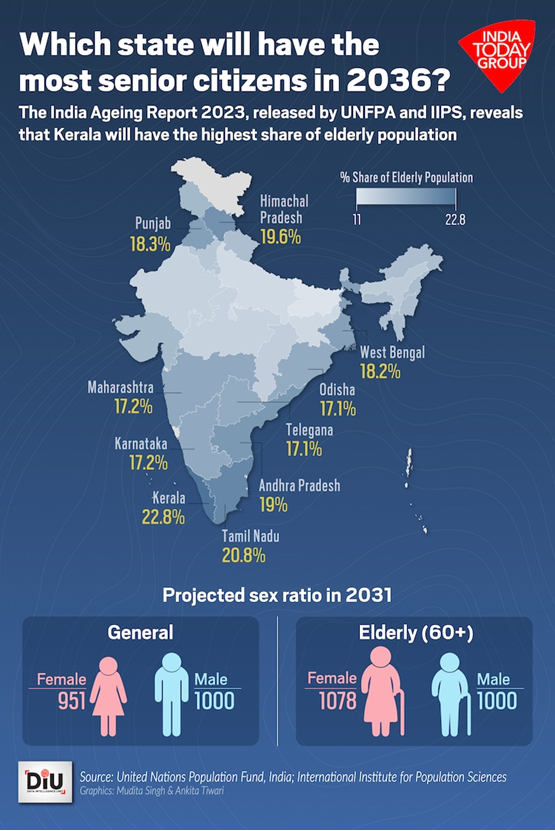AN AGEING INDIA: THE MAGNITUDE AND THE MULTITUDE
Relevance: GS 2 – Welfare schemes for vulnerable sections of the population by the Centre and States and the performance of these schemes
Why in the News?
- Rising Ageing Population: India is witnessing a significant increase in its ageing population.
- Need for Preparatory Measures: There’s an urgent need to focus on strategies to support the elderly.
- Key Areas of Focus: Social Independence, Financial Independence, Active Life Course
The Ageing Phenomenon: Global Context
- Increased longevity due to improved healthcare and lower reproduction rates.
- Redefining ageing beyond just chronological age, considering functional abilities and evolving vulnerabilities.
- Vulnerabilities in Later Life (India): Four main vulnerabilities are Restricted daily activities, multiple health conditions (multi-morbidity), poverty, and lack of income.
- Prevalence of Around 20% of elderly experience each vulnerability (LASI, 2017-18).
- Variation: These vulnerabilities differ significantly across Indian states.
- Addressing Vulnerabilities:
- Multi-pronged approach: Inclusion, social security measures.
- Life course perspective: Early life interventions to promote healthy aging, not just financial security.
- Focus on active and productive years: Maximize potential of longer lifespans.
- Shifting Evaluation Focus: Current evaluations prioritize individual attributes, neglecting social and environmental factors that shape later life.
Magnitude of the Elderly Population
- Population Growth:
- Estimated to reach 319 million by mid-century.
- Growing at a rate of around 3% per year.
- Gender Demographics:
- Feminine skew with a sex ratio of 1,065 females per thousand males.
- 54% of elderly women will be widows.
- Living Arrangements:
- 6% of elderly men live alone, compared to 9% of elderly women.
- 70% of the elderly population resides in rural areas.
- Welfare Targeting: These statistics are crucial for developing targeted welfare measures for the elderly.
Population and Familial Transition
- Rising Elderly Population:
- The increase in the elderly population coincides with familial transitions.
- Familial transition is reflected in smaller average household sizes.
- Household Composition:
- The structure of households and the accommodation patterns of the elderly are crucial.
- There are households without elderly members and households with multiple elderly members.
- Instances of elderly living with other elderly members are becoming more common.
- Dependence and Care:
- Households with elderly members show a higher focus on dependence, care provisioning, social security, and financial protection.
- Vulnerabilities in elderly individuals often arise from household characteristics rather than personal traits.
Healthy Ageing
Comparing Today’s and Tomorrow’s Elderly – Future elderly may have advantages in education, life preparation, and economic dependence.
- Health and Quality of Living: Despite these advantages, future elderly may face health adversities and lower quality of life due to rising longevity and chronic ailments.
- Focus on Prospective Elderly:
- The concept of healthy ageing should emphasize the future elderly, not just the current elderly population.
- Activities of Daily Living (ADL):
- Limitations in ADL worsen with age among the current elderly.
- There is potential for these limitations to be less severe and occur later in life for future elderly.
- Health Promotional Measures:
- Emphasize health promotion among late-age adults to ensure healthy ageing.
- This will help integrate the elderly population into productive activities across various spheres.
Challenges & Emerging Concerns
- Health Reporting:
- A quarter of the elderly report poor health, compared to 20% of those aged 45 and above.
- Increasing instances of poor health earlier in life are concerning.
- Chronic Diseases and Disabilities:
- 75% of the elderly suffer from one or more chronic diseases.
- 40% of individuals aged 45 and above have some form of disability.
- Reducing this health burden is essential for the future.
- Major Health Threats:
- Diabetes and cancer are significant threats among India’s elderly.
- Mental Health: 20% of those aged above 45 self-report mental health ailments, mainly depression. This rate is higher compared to the elderly, indicating an emerging concern.
- Food Insecurity
- 6% of individuals over 45 years ate smaller portions or skipped meals.
- 3% did not eat despite being hungry.
- This food insecurity affects nutrition and can lead to morbidities.
- Life Expectations and Abuse:
- Elderly individuals have low expectations from life.
- Insecurities and vulnerabilities lead to varied forms of abuse.
- 5% report abuse, with women in rural areas being particularly affected.
Protection Measures & Need for Social Agency
- Welfare Provisioning:
- Welfare measures, legal recourse, and concessions are in place for the elderly.
- Awareness of these provisions is low:
- Only 12% know about the Maintenance and Welfare of Parents and Senior Citizens Act, 2007.
- 28% are aware of various concessions for the elderly.
- Limited awareness of schemes like IGNOAPS, IGNWPS, and Annapurna.
- Creating Social Agency:
- There’s a need to create social agency for the elderly.
- Innovative institutions can change their perception from being liabilities to assets.
- Future Transformations:
- Youth mobility, digitalization in service delivery, and social exclusion highlight the need for active life courses for the future elderly.
- Focus on ensuring the elderly qualify for Equip Life with Dreams Energy Renewal Longing and Yearn (ELDERLY).
Associate Articles
https://universalinstitutions.com/elderly-population-in-india/
https://universalinstitutions.com/preparation-for-an-aging-population/
Mains question
Discuss the challenges faced by India’s elderly population in terms of health, food security, and social support, and suggest measures to enhance their welfare and active participation in society. (250 words)




